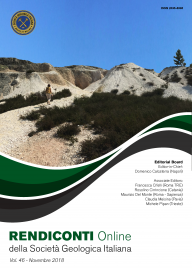
Mappatura delle aree di occorrenza dei principali eventi di pioggia in Toscana dal 2004 al 2016
Massimo Perna (a), Valerio Capecchi (a), Alfonso Crisci (b), Giulio Betti (a), Giorgio Bartolini (c), Francesco Manetti (c), Guido Lavorini (d) & Bernardo Gozzini (c)
(a) CNR Ibimet/Consorzio LaMMA.
(b) CNR Ibimet.
(c) Consorzio LaMMA.
(d) Regione Toscana - S.I.T.A. - P.O. geologia, pedologia e banche dati geotematiche.
Corresponding author e-mail: perna@lamma.rete.toscana.it.
DOI: https://doi.org/10.3301/ROL.2018.65
Volume: 46/2018
Pages: 144-148
Abstract
The detection of the rainfall events is part of the Tuscany Region administration project, which aims to detect shallow landslides triggered by heavy rainfall events. The project has followed two main linked objectives: (i) acquiring knowledge on shallow landslides and their relationships with the triggering weather events. (ii) provide indepth knowledge of the main intense precipitation events occurring in
recent years in Tuscany. At present, the study includes spatial analysis of 70 intense precipitation events from 2004 to 2016. For such events, a spatial statistical analysis allowed to highlight the most affected areas. In order to outline these areas, the cumulative precipitation measured at the rain gauges was assessed for each event, and it was correlated to return values of rainfall events of the same duration and
for different return times. Thus, the exceptionality of the events on the territory has been related to the time series of every rain gauge. A unique threshold parameter was defined by identifying areas where the precipitation exceeded a given return time value (related to the duration of the event) for the stations within the identified area. The parameters (a and n) of the power law that regulates the relationship
between rainfall height and precipitation duration for a given return time (h (t) = a × t n) have been provided by the Centro Funzionale Regionale (CFR). So for each rainfall event of different duration (24-48-72-96 hours) and for different return times (2, 5, 10, 20, 30, 50, 100, 150, 200 and 500 years), rainfall level have been calculated. Once the rain gauges most affected by the event have been identified, a simple buffer helped to highlight the main affected area. In the case of events
where some stations exceeded the 10-year Return Time (RT), it was preferred to process both the areas that enclosed these stations and the buffer with the gauges where the rainfall level exceeded the RT of 5 years, both being very significant from a point of view of the entity’s ‘event. Same for events with RT thresholds exceeded at 2 and 5 years.
Keywords
Get Full Text